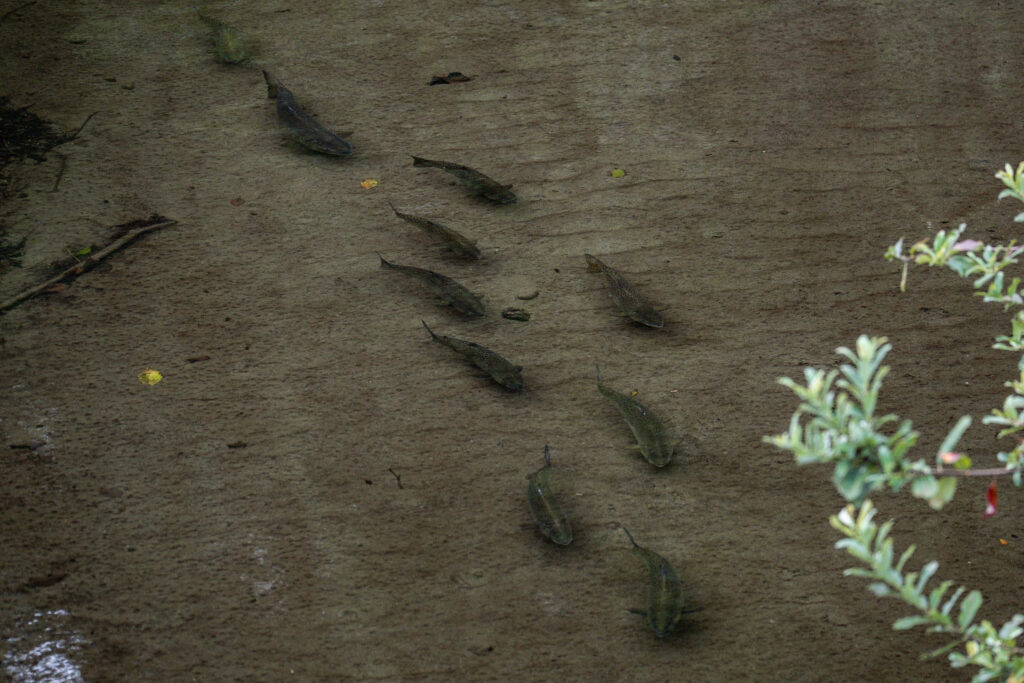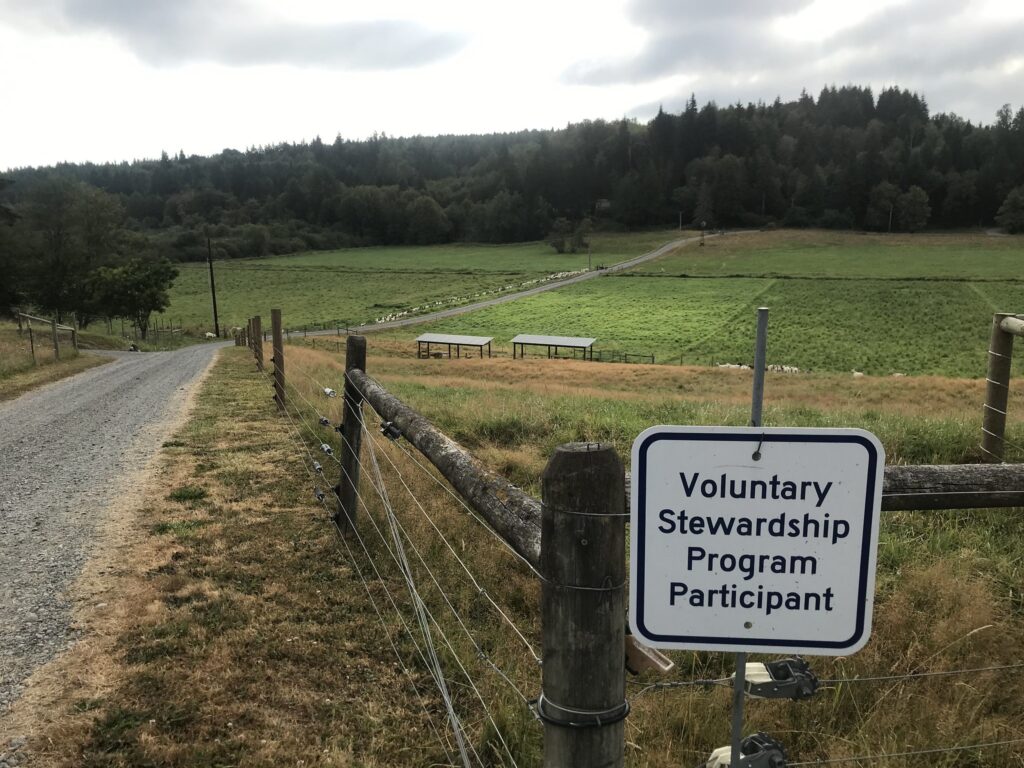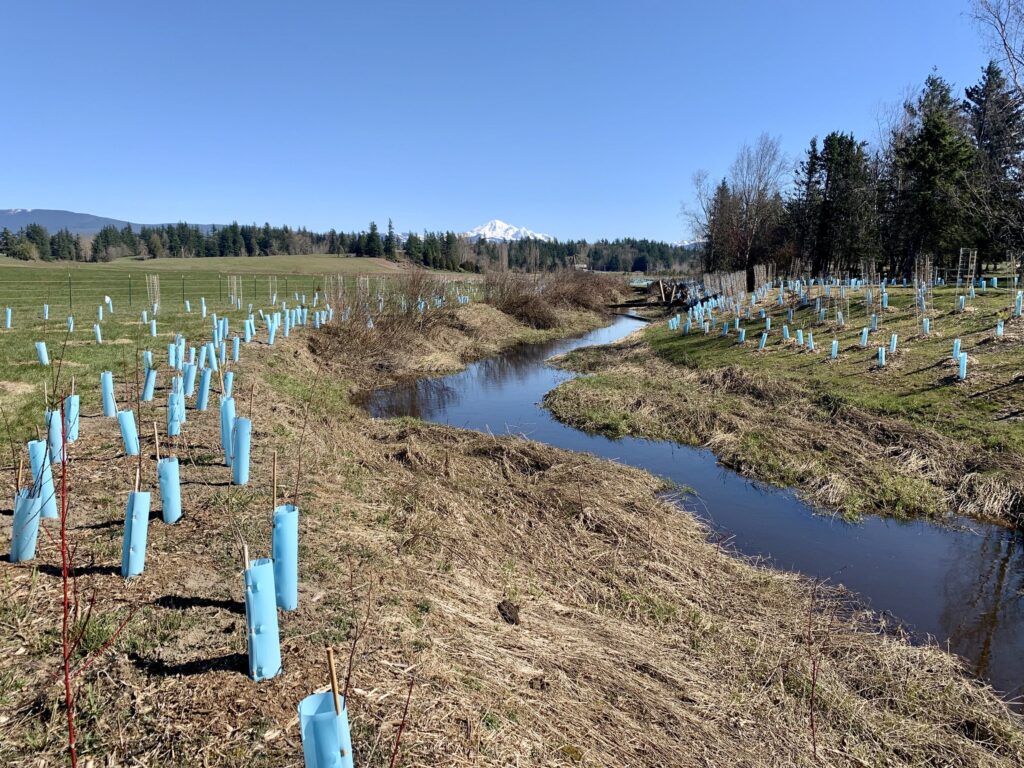Farms and Fish: Finding a Path Forward Together
Riparian Buffers, Climate Smart Ag, and Middle Housing
This year at the Washington Legislature, tension between agriculture and salmon is palpable. At the center of the debate are riparian buffers, the vegetation alongside streams and rivers necessary to support habitat and water quality. Some solutions are already on the table this session, with opportunities that benefit both Washington salmon and farmers.

HB 1838, also known as The Lorraine Loomis Act, would include salmon recovery as a goal in the Growth Management Act. The Department of Fish and Wildlife would identify riparian zones on salmon-bearing waterways and landowners would be required to establish and maintain a riparian buffer.
With concerns raised by the agricultural community, the bill will be held in committee this year. Farmers in riparian zones would have to take land out of production to provide ecosystem services. Some cost sharing would be included, but impacted farmers are at risk of lost income, new expenses, and an unfamiliar responsibility. Add to that the challenges of extreme weather and supply chain disruption, and the future of farming grows more uncertain.
The needs of both salmon and agriculture should shape this legislation. As a staple food and treaty-protected resource, salmon are integral to the cultures of Pacific Northwest tribes. Yet agriculture is critical to feed the population, with rural and urban communities alike celebrating our heritage and food systems. As said by a farmer in the hearing for the bill, salmon and red potatoes sit side by side on our plates.
Missing from the intent of HB 1838 is the goal of farm viability, which ultimately supports the success of salmon recovery. When farmers are forced to leave the land, parcels are often subdivided and sold to the highest bidder. Low density residential growth, also known as urban sprawl, is a threat to both agriculture and habitat. It is in the interest of farms and fish to find ways to work together.
Legislators have said they welcome ideas from agriculture on how to move forward with salmon recovery. The push for a strong regulatory approach is an indicator that voluntary conservation has not been successful. Which begs the question: why?

To be successful, voluntary conservation needs to be sufficiently funded. Working together to find funding is a principle of the Voluntary Stewardship Program approved by the Legislature in 2011. Farmers need technical support for new practices and farm planning. They need resources for materials, labor, and equipment. They need compensation – not just for lost revenue, but for providing critical ecosystem services.
The Spokane Conservation District has an innovative solution. Their Commodity Buffer Program speaks in a language farmers understand: the productivity of their land. Riparian buffers are compensated like a crop, with payments based on buffer size and type, tilling practices, and adjacent crops. By the fifth year of this program, they enrolled 117 miles of streams, leveraging $135,000 of state funding with federal incentives from the Natural Resource Conservations Service (NRCS) of the U.S. Department of Agriculture. Commodity buffers hit a triple bottom line: farm viability, water quality, and food security.
Washington should leverage federal resources by providing sufficient funding for voluntary conservation. Funding through NRCS comes with two strings attached: matching funds and voluntary stewardship. For years, millions of dollars have been left on the table because the Conservation Reserve Enhancement Program has not been fully funded. HB 1838 would have undercut this opportunity further. If riparian buffers become regulated to the degree that conservation is no longer voluntary, farmers will lose access to federal funding that provides effective tools for salmon recovery.
In addition to riparian buffers, there are many things agriculture can do to support salmon. Farmers need access to a variety of tools to build soil health and sequester carbon. These practices offer co-benefits for both the farmer and environment. Healthy soils are not only more productive, they retain more moisture, improve water quality, serve as a carbon sink, and are more resilient against extreme weather.
Sustainable Farms and Fields invests in farmers eager to adopt climate smart practices. Sponsored by former Sen. John McCoy, this program was established at the State Conservation Commission in 2020. The Commission has requested $2 million for its first year of funding, which is included in the Governor’s climate package.
This program is an example of what can happen when farmers are at the table with solutions. Over 200 farmers contributed to creating Sustainable Farms and Fields through a survey funded by the Legislature. They shared their interests and needs to implement climate smart practices, including cover crops, no-till farming, and manure management. Riparian buffers are not only eligible, they receive priority.

The legislature should amply fund Sustainable Farms and Fields and strengthen the program by approving HB 1631. Sponsored by Rep. Sharon Shewmake, HB 1631 will establish a network of advisors who will, through the conservation districts, provide technical support for farmers and food processors to increase energy efficiency, sequester carbon, and reduce greenhouse gas emissions.
Agricultural easements are another tool for voluntary conservation. On Kodama Farm, the Jefferson Conservation District partnered with the North Olympic Salmon Coalition to restore riparian habitat and preserve the farm. An easement held by the Jefferson Land Trust protects the farmland outside the riparian areas from development, making the land more affordable for the young farmers. This project also leveraged federal funding, this time through the National Estuary Program of the Environmental Protection Agency.
The Legislature should fund easements through the Farmland Protection and Land Access (FPLA) program. This year the State Conservation Commission requested $2 million for FPLA. This program helps land trusts secure at-risk farmland in a fast-paced real estate market by leveraging a new loan financing program at the Housing Finance Commission.
Easements allow the landowner to voluntarily remove development rights from the land, which keeps farmland affordable and compensates for the loss in land value. The land is preserved for generations to come. The Washington Food Policy Forum has recommended $100 million in funding for easements and development rights as a matter of food security, yet the Governor did not include the $2 million for FPLA in his capital budget proposal. The Legislature should.
Agriculture and salmon can do good things for each other. And there is a greater threat we should face together: urban sprawl. The conversion of natural and working lands to low density residential housing forever changes the landscape of Washington.
Housing is not often included on the policy agenda for agriculture – but it should be. The lack of urban housing is a problem for rural communities. Our Farms Under Threat analysis shows that Washington lost nearly 100,000 acres of agricultural lands to housing development between 2001 and 2016. The future of food is uncertain, and we are at a critical juncture.
Statewide middle housing should move forward for the protection of natural and working lands. Cities have not built enough housing, creating greater pressure to develop farmland and habitat. SB 5670 and HB 1782, sponsored by Sen. Mona Das and Rep. Jessica Bateman, will relieve that pressure by legalizing middle housing in cities across the state. Housing types range from duplexes to sixplexes, depending on population and access to transit.
Farmers need to know they have a future in Washington. Alongside tribes and other advocates for Washington farms and salmon, many are eager to help shape that future. Our mutual values have brought us together before, and we have seen success when we put the right tools in place. We should build on these efforts with a strong spirit of collaboration. If we can find ways to move forward together, we will be much more effective as we face threats in the future. Read more on AFT’s mission on Washington State Policy here.

